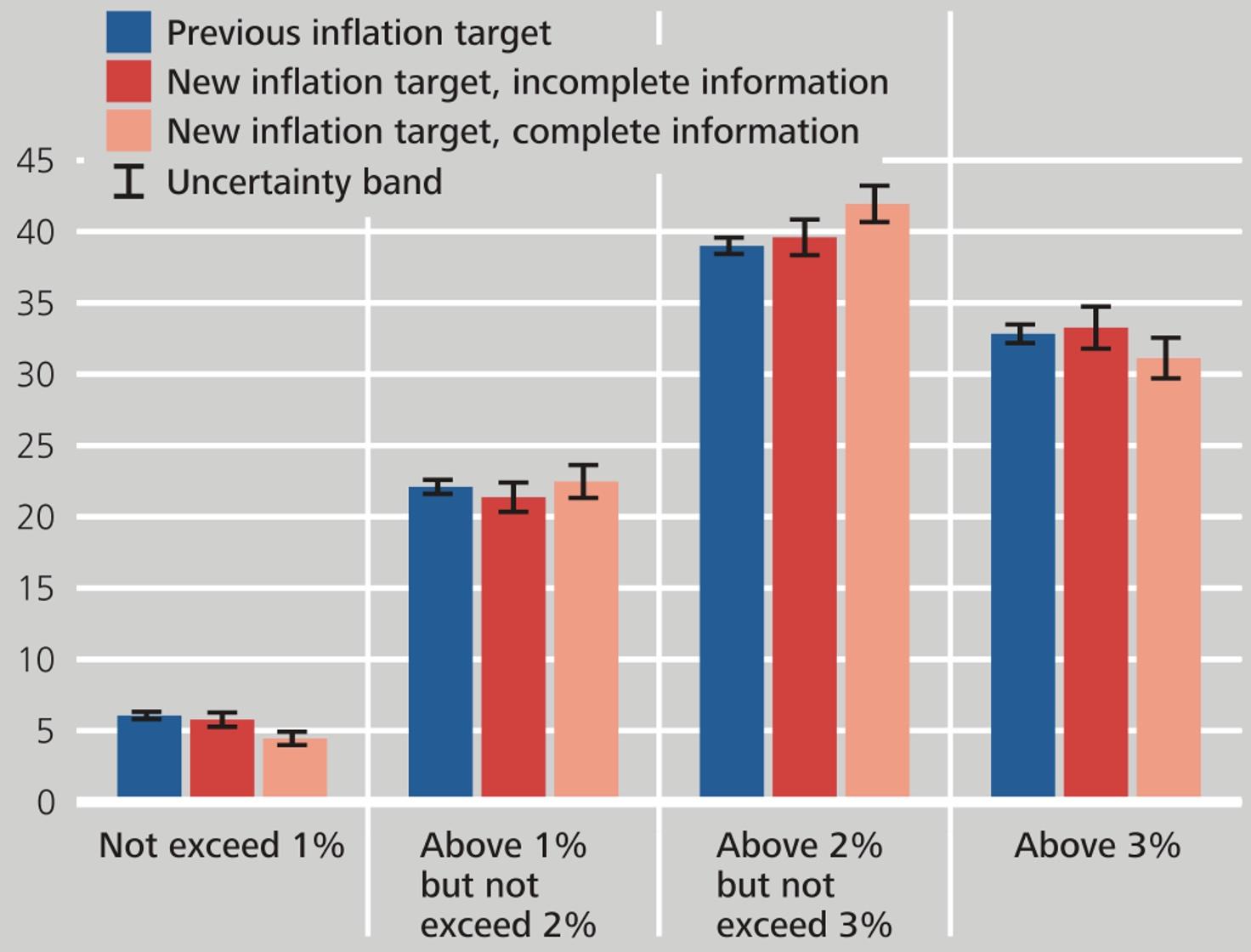In July 2021, the Governing Council of the ECB announced its new monetary policy strategy. Having previously pursued to keeping inflation “below, but close to, 2%” over the medium term, it now considers price stability to be best maintained by aiming for a 2% inflation target over the medium term. The new target is “symmetric”, meaning that deviations both above and below target are equally undesirable. To prevent negative deviations becoming entrenched, however, the ECB’s actions might result in the possibility of transitory periods in which inflation is moderately above 2%.
The ECB strives to make its communication with the general public as clear and intelligible as possible. To assess whether households take the ECB’s strategy into account when forming beliefs about future price developments, we used the August 2021 Bundesbank Online Panel Households (BOP-HH) to ask around 3,000 households about their inflation expectations for the next two to three years, just after the changes to monetary policy were introduced. We present households with information about the new and the previous ECB strategy using a randomised control trial. There are three steps to the experiment. To start with, all participants are told that the strategy until July had been to keep annual inflation “below, but close to, 2%” over the medium term and that, under the new strategy in place since July, the target is inflation of 2% over the medium term. The fact that this new target is symmetric, meaning that negative and positive deviations from it are considered equally undesirable, is also explicitly laid out in an easy-to-understand manner.
Second, all participants are asked to assume that the ECB, as before, is aiming for an inflation rate of “below, but close to, 2%” over the medium term. The respondents then state what inflation rates they expect for the next two to three years, which coincides with the ECB’s projection horizon. Third, the participants are randomly split into groups and presented with different assumptions in terms of monetary policy and the inflation environment. A total of five subsamples were formed in the August 2021 survey. The first group was instructed to assume that the ECB is aiming for an annual inflation rate of 2% over the medium term, in line with its new strategy. Corresponding with the information text at the beginning, the respondents again received the information that this inflation target is symmetric, meaning that negative and positive deviations of inflation from the target are equally undesirable. The text for the second group is essentially the same as that for the first; however, they were also provided with an explicit version of the ECB’s official press release on the new inflation target that details the possibility of above-target inflation.
Comparing the previous and the new monetary policy strategies
Figure 1 Inflation expectations for the next 2-3 years
Source: Deutsche Bundesbank.
Figure 1 shows how medium-term inflation expectations under the previous strategy compare to the new monetary policy strategy. The bar chart shows the average individual probabilities for the “below, but close to, 2%” policy in dark blue; those for the “symmetrically 2%” policy are shown in dark red, and the light red bars depict expectations when the “symmetrically 2%” policy is supplemented with information about the possibility of a temporarily above-target inflation rate. Comparing the first two bars in each case – i.e. dark blue with dark red – we see a moderate shift in the probability mass towards the right. This shift implies that inflation expectations are somewhat higher under the new strategy than under the previous one. When comparing the dark blue bars and the light red bars, however, the differences are more distinct.
On the basis of these observations, we can infer that the respondents initially draw relatively little distinction between an inflation target of “below, but close to, 2%” and “symmetrically 2%”. It appears, however, that the survey participants pay careful attention to the information provided: the additional explanation that the inflation rate may exceed the 2% target under certain circumstances produced a statistically significant shift to the right in inflation expectations. Most notably, more respondents stated that they expect an inflation rate above 2% but no higher than 3% over the medium term. Meanwhile, under the ECB’s new strategy, inflation rates below 1% and above 3% were seen as significantly less likely than in the context of the previous strategy and also than under the assumption of the “symmetrically 2%” inflation target without the additional mention of a temporary overshoot.
Additional assumptions about the inflation setting
Central banks can more easily reach their inflation target when they are able to steer inflation expectations through their communication. To test whether households would adjust their expected path of inflation in line with the communicated strategy, we presented three further groups of respondents with an additional assumption. Specifically, these survey participants are asked to imagine that they are in a low inflation environment, as has been the case in the euro area over the last ten years, and to assume that the inflation rate will be only 1% for the next twelve months. This expanded assumption models a significant negative deviation from the inflation target, which, according to the ECB’s new monetary policy strategy, is to be avoided to become entrenched.
Having established this premise, one of the groups is asked to assume that the previous ECB policy of “below, but close to, 2%” remains in force. Two further groups are asked to assume that the new “symmetrically 2%” inflation target applies. As before, one of these groups of respondents is then shown the incomplete version of the ECB press release which does not mention the possibility of temporarily overshooting the inflation target, while the other group of respondents receives the complete version. Both groups of participants are asked to assume that the inflation rate will be just 1% over the next twelve months. These additional assumptions should allow a comparison of the extent to which the previous and the new monetary strategy have an effect on households’ expected inflation paths. Provided households have trust that the ECB is committed to its new strategy and has the tools to affect inflation in the desired way, they should adjust their inflation expectations to be above the 2% target under the new strategy. In contrast, when the previous strategy of “below, but close to, 2%” is assumed, there should be somewhat less strong adjustment of expectations, as the strategy did in principle not tolerate potentially overshooting the inflation target following a hypothetical below-target rate of inflation of 1%.
Figure 2 Inflation expectations for the next 2-3 years; additional assumption of a current inflation rate of 1%
Source: Deutsche Bundesbank.
Figure 2 displays the survey results when the additional assumption about the inflation rate is taken into account. Similarly to the results in the previous chart, Figure 2 shows that, in scenarios where inflation has been below the target value for some time already, the new strategy is better suited to guiding households towards expecting higher inflation rates than the previous inflation target. The differences between the individual probability distributions in the bar chart – shown by comparing dark blue and dark red – are significant, given an error probability of 10%. This result is primarily driven by the differences between inflation rates of above 1% but no higher than 2% and above 2% but no higher than 3%. Those survey participants who had complete information about the new monetary policy strategy set their inflation expectations significantly higher than those who assumed the previous strategy would apply. This is shown in the comparison of the dark blue and light red bars. Taking into account the black uncertainty bands, we can see that the differences are highly statistically significant. In addition, there is a greater probability of higher medium-term inflation expectations, some even exceeding 3%, when the current inflation rate is assumed to fall considerably short of the inflation target.
In a more detailed regression analysis, which is not shown here, these statistically significant differences between the groups of respondents were confirmed to also apply to the average individual expected mean inflation rate.
Conclusion
In sum, our survey results show that households can distinguish between the ECB’s new symmetrical inflation target of an annual inflation rate of 2% over the medium term and the previous monetary policy target of an annual inflation rate of “below, but close to,2%” over the medium term. The increase in inflation expectations is particularly pronounced when respondents are explicitly informed about the possibility of temporarily exceeding the inflation target, which is entailed in the new ECB strategy. Moreover, households understand the intended inflation path. After a period of very low inflation rates, which fall short of the target value, the majority of respondents expects inflation to exceed the target in the near future. The results illustrate that clear monetary policy communication can effectively guide the expectation formation process of private households.
Authors’ note: This blog is based on Hoffmann, Mathias, Emanuel Mönch, Lora Pavlova and Guido Schultefrankenfeld (2021), “The effects of the ECB’s new inflation target on private households’ inflation expectations”, Bundesbank Research Brief 43rd edition, November.








